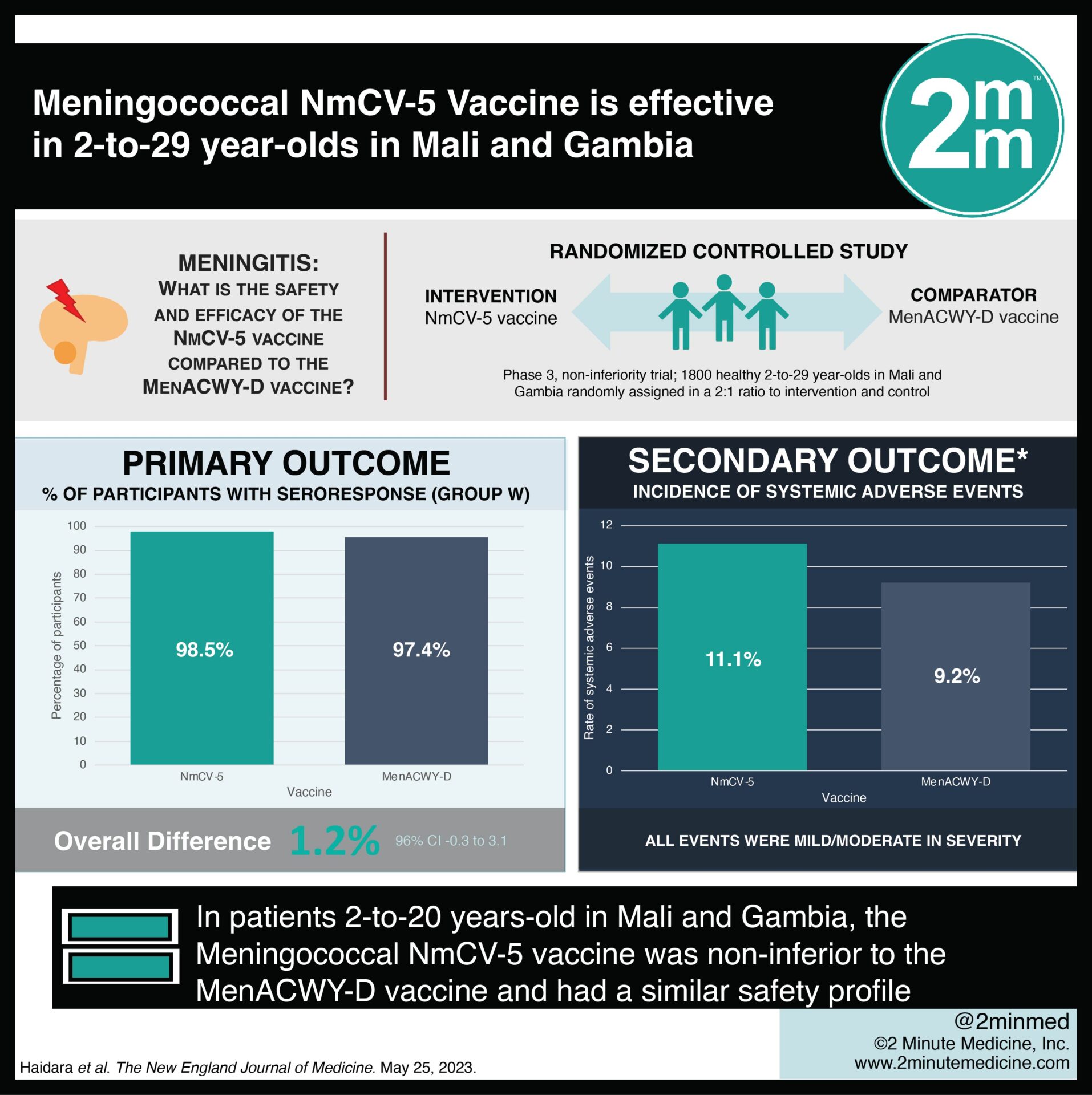1. In this randomized controlled trial, the NmCV-5 vaccine elicited an immune response that was noninferior to the MenACWY-D vaccine in two-to-29-year-olds in Mali and Gambia.
2. The NmCV-5 vaccine had a similar incidence of adverse events as compared to the MenACWY-D vaccine.
Evidence Rating Level: 1 (Excellent)
Study Rundown: The highest incidence of meningitis and associated death occurs in the African meningitis belt. This stretches from Gambia and Senegal in the west to Ethiopia in the east. In this region, meningitis epidemics predominantly caused by Neisseria meningitidis occur at a relatively high rate. Although there is a quadrivalent meningococcal ACWY conjugate vaccine, supply and cost constraints have limited their use in Africa. Therefore, the Serum Institute of India and PATH (Program for Appropriate Technology in Health) developed a pentavalent meningococcal ACWYX conjugate vaccine (NmCV-5) with the goal of eliminating meningococcal disease in sub-Saharan Africa. However, there is a knowledge gap in understanding the safety and immunologic noninferiority of the NmCV-5 vaccine compared to the World Health Organization (WHO)-approved MenACWY-D vaccine. This study found that the NmCV-5 vaccine elicited immune responses that were noninferior to those for all four meningitis serotypes in common with the MenACWY-D vaccine. It also elicited immune responses for serogroup X without evident safety concerns. This study was limited by product licensure on the basis of immunogenicity. Nevertheless, these study’s findings are significant, as they demonstrate that the NmCV-5 vaccine is safe and noninferior to the prior WHO-approved MenACWY-D vaccine in patients aged two-to-29 in Mali and Gambia.
In-Depth [randomized controlled trial]: This phase three, double-blinded, randomized noninferiority trial was conducted in Mali and Gambia. Patients who had provided written informed consent from parents or guardians and provided written assent were eligible for the study. Patients who were unable to provide consent were excluded from the study. The primary outcome measured was to show that the immune responses to meningococcal serogroups A, C, W, and Y that were generated by the NmCV-5 vaccine were noninferior to those generated by the MenACWY-D. Outcomes in the primary analysis were assessed via a prospective alpha-allocation scheme with a log-transformed analysis of covariance. Based on the primary analysis, the percentage of participants with a seroresponse ranged from 70.5% (95% Confidence Interval [CI], 67.8 to 73.2) for serogroup A to 98.5% (95% CI, 97.6 to 99.2) for serogroup W. The percentage with a serogroup X response was 97.2% (95% CI, 96.0 to 98.1) in the patients who received the NmCV-5 vaccine. The overall difference between the two vaccines in seroresponse for the four shared serogroups ranged from 1.2 percentage points (96% CI, −0.3 to 3.1) for serogroup W to 20.5 percentage points (96% CI, 15.4 to 25.6) for serogroup A. The serogroup X component of the NmCV-5 vaccine generated seroresponses and geometric mean titers that met the prespecified noninferiority criteria. In summary, this study demonstrates that the NmCV-5 vaccine elicited immune responses that were noninferior to the MenACWY-D vaccine in patients aged 2-to-29 in Mali and Gambia.
©2023 2 Minute Medicine, Inc. All rights reserved. No works may be reproduced without expressed written consent from 2 Minute Medicine, Inc. Inquire about licensing here. No article should be construed as medical advice and is not intended as such by the authors or by 2 Minute Medicine, Inc.









